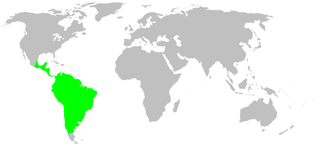
Lyssomanes is a spider genus of the Salticidae family. About 90 species have been described, ranging from South and Central America, up to the southern United States.

Micrathena is a genus of orb-weaver spiders first described by Carl Jakob Sundevall in 1833. It contains more than a hundred species, most of them Neotropical woodland orb-weavers. The name is derived from the Greek "micro", meaning "small", and the goddess Athena. It includes over a hundred species, including four in the United States and Canada. Among these four species, female spined micrathena have five pairs of conical tubercles, female M. mitrata have two short posterior pairs, and female arrow-shaped micrathena have three pairs. Species with extremely long spines evolved at least eight times in the genus Micrathena and likely function as anti-predator defenses. The only species recorded from Canada is M. sagittata, found in Ontario.

Theridion is a genus of tangle-web spiders with almost 600 described species around the world. Notable species are the Hawaiian happy face spider (T. grallator), named for the iconic symbol on its abdomen, and T. nigroannulatum, one of few spider species that lives in social groups, attacking prey en masse to overwhelm them as a team.

Cryptachaea is a genus of spiders in the Theridiidae family.

Senoculus, also called bark hunters, is a genus of Central and South American araneomorph spiders and the only genus in the family Senoculidae. It was first described by Taczanowski in 1872.

Mangora is a genus of orb-weaver spiders first described by O. Pickard-Cambridge in 1889.
Dipoena is a genus of cob-web spiders in the family Theridiidae, containing more than 160 species.
Dubiepeira is a genus of South American orb-weaver spiders first described by Herbert Walter Levi in 1991.
Eustala is a genus of orb-weaver spiders first described by Eugène Simon in 1895.
Hingstepeira is a genus of South American orb-weaver spiders first described by Herbert Walter Levi in 1995.
Hypognatha is a genus of orb-weaver spiders first described by F. E. Guérin-Méneville in 1839.
Metazygia is a genus of orb-weaver spiders first described by F. O. Pickard-Cambridge in 1904. They physically resemble members of Nuctenea, but they do not have fine setae on the carapace.
Ocrepeira is a genus of orb-weaver spiders first described by George Marx in 1883.
Tatepeira is a genus of Central and South American orb-weaver spiders first described by Herbert Walter Levi in 1995.
Wagneriana is a genus of orb-weaver spiders first described by F. O. Pickard-Cambridge in 1904.
Alpaida is a genus of South American orb-weaver spiders first described by Octavius Pickard-Cambridge in 1889.





